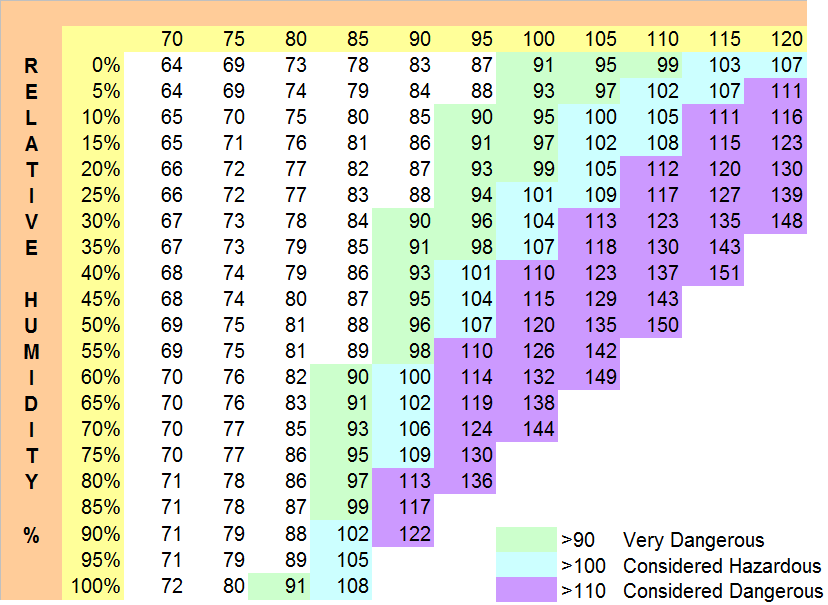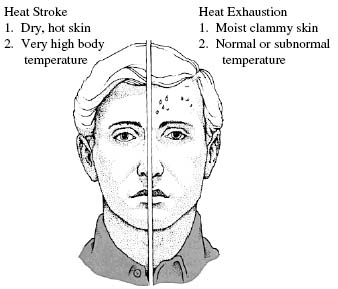Heat Stress

A National Problem
Heat Stress kills by taxing the human body beyond its abilities. In a normal year, about 175 Americans succumb to the demands of summer heat.
Among the large continental family of natural hazards, only the cold of winter-not lightning, hurricanes, tornadoes, floods, or earthquakes-takes a greater toll.
In the 40-year period from 1936 through 1975, nearly 20,000 people were killed in the United States by the effects of heat and solar radiation. In the disastrous heat wave of 1980, more than 1,250 people died and these are direct casualties.
No one can know how many more deaths are advanced by heat wave weather-how many diseased or aging hearts surrender that under better conditions would have continued functioning.
North American summers are hot; most summers see heat waves in one section or another of the United States. East of the Rockies, they tend to combine both high temperature and high humidity although some of the worst have been catastrophically dry.
Considering this tragic death toll, the National Weather Service (NWS) has stepped up its efforts to alert more effectively the general public and appropriate authorities to the hazards of heat waves-those prolonged excessive heat/humidity episodes. Based on the latest research findings, the NWS has devised the “Heat Index.”
Temperature

Direct sunshine can increase these Heat Index values by up to 15 degrees. Strong, hot, dry winds are also very dangerous Sweating by itself does nothing to cool the body unless the water is removed by evaporation – and high humidity retards evaporation.
Heat Stress occurs when the body is unable to cool itself by sweating. Several heat-induced illnesses such as heat stress, heat exhaustion or the more severe heat stroke can occur and can result in DEATH.
How Heat Affects the Body Human
Human bodies dissipate heat by varying the rate and depth of blood circulation, by losing water through the skin and sweat glands, and-as the last extremity is reached-by panting, when blood is heated above 98.6 degrees.
The heart begins to pump more blood, blood vessels dilate to accommodate the increased flow, and the bundles of tiny capillaries threading through the upper layers of skin are put into operation.
The body’s blood is circulated closer to the skin’s surface, and excess heat drains off into the cooler atmosphere. At the same time, water diffuses through the skin as perspiration. The skin handles about 90 percent of the body’s heat dissipating function.
Sweating, by itself, does nothing to cool the body, unless the water is removed by evaporation, and high relative humidity retards evaporation.
The evaporation process itself works this way: the heat energy required to evaporate the sweat is extracted from the body, thereby cooling it.
Under conditions of high temperature (above 90 degrees) and high relative humidity, the body is doing everything it can to maintain 98.6 degrees inside.
The heart is pumping a torrent of blood through dilated circulatory vessels; the sweat glands are pouring liquid-including essential dissolved chemicals, like sodium and chloride onto the surface of the skin.
The most serious heat related illness is heat stroke. The symptoms are confusion, irrational behavior, convulsions, coma, and death.
While over 20% of heat stroke victims die regardless of health or age, children seem to be more susceptible to heat strain than adults. In some cases, the side effects of heat stroke are heat sensitivity and varying degrees of brain and kidney damage.

Signs and symptoms of heat stroke and heat exhaustion
- Protect Health – Heat illness is preventable and treatable before it is life threatening.
- Improve Safety – Any heat stress can impair functioning.
- Increase Productivity – People work slower and less efficiently when they are suffering from heat stress.
- Muscle cramps
- Weakness or exhaustion
- Dizziness
- Rapid pulse
- Breathing becomes shallow
- Headache
- Seizures
- Loss of appetite, nausea, or vomiting
- Altered mental status or unresponsive
- Hot skin that is dry or moist
Employers, supervisors and workers all have an essential role to play in preventing heat stress. Each member of the team should use good judgment to prevent heat related illness. A heat stress control program should protect all workers at the operation, from those who can work comfortably in heat to those in poor physical shape.
When possible, schedule heavy tasks and work requiring protective gear for cooler, morning or evening hours. Prolonged, extreme hot temperatures mandate the postponement of nonessential tasks.
Most protective garments limit sweat evaporation (but not sweat production) and chemical-resistant suits can cause rapid dehydration if sweat is not replaced. One way to slow the buildup of heat when wearing PPE is to use special cooling garments.
Key Elements for Controlling Heat Stress
- Drink one glass of water every 15 to 30 minutes worked, depending on the heat and humidity.
- This is the best way to replace lost body fluid.
- Read medication labels to know how cause the body to react to the sun and heat.
- Avoid alcohol and drugs as they can increase the effects of heat.
- Build up tolerance for working in the heat. Heat tolerance is normally built up over a one to two week time period.
- Take breaks to cool down. A 10 – 15 minute break every two hours is effective.
- Adapt work and pace to the weather.
- Provide heat stress training to workers and supervisors.
- Manage work activities and match them to employees’ physical condition.
- Use special protective gear, such as cooling garments and cooling vests on “early entry” workers.
- Know heat stress first aid techniques.
Know These Heat Disorder Symptoms
SUNBURN: Redness and pain. In severe cases swelling of skin, blisters, fever and headaches.
First Aid: Ointments for mild cases if blisters appear and do not break. If breaking occurs, apply dry sterile dressing. Physician should see serious, extensive cases.
HEAT CRAMPS: Painful spasms usually in muscles of legs and abdomen possible. Heavy sweating.
First Aid: Firm pressure on cramping muscles, or gentle massage to relieve spasm. Give sips of water. If nausea occurs, discontinue use.
HEAT EXHAUSTION: Heavy sweating, weakness, skin cold, pale and clammy. Pulse thready. Normal temperature possible. Fainting and vomiting.
First Aid: Get victim out of sun. Lie down and loosen clothing. Apply cool, wet clothes. Fan or move victim to air-conditioned room. Sips of water. If nausea occurs, discontinue use. If vomiting continues, seek immediate medical attention.
HEAT STROKE (or sunstroke): High body temperature (106° F. or higher). Hot dry skin. Rapid and strong pulse. Possible unconsciousness.
First Aid: HEAT STROKE IS A SEVERE MEDICAL EMERGENCY. SUMMON EMERGENCY MEDICAL ASSISTANCE OR GET THE VICTIM TO A HOSPITAL IMMEDIATELY. DELAY CAN BE FATAL. Move the victim to a cooler environment Reduce body temperature with cold bath or sponging. Use extreme caution. Remove clothing, use fans and air conditioners. If temperature rises again, repeat process. Do not give fluids. Persons on salt restrictive diets should consult a physician before increasing their salt intake.